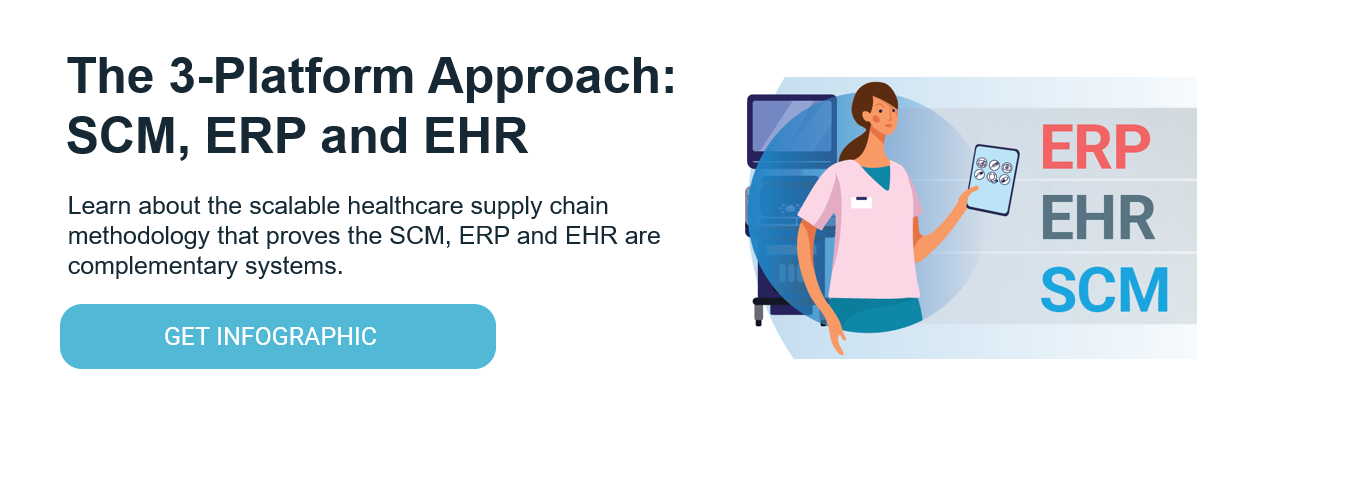ERP vs. SCM: What’s the Difference and Why?

While enterprise resource planning (ERP) systems have long been positioned as “supply chain management (SCM) platforms,” for healthcare, they were not designed for this purpose and, therefore, lack key capabilities for enterprise-wide supply chain visibility and control.
Let’s look at the difference between an ERP system and a true SCM platform that fully integrates with the electronic health record (EHR) when managing three different types of supply inventory — medical/surgical, perioperative and pharmaceuticals.
Three Areas of Difference Between ERP vs. SCM
1. Medical/Surgical Inventory Management
A health system’s medical/surgical supply inventory contains a huge volume of low-cost products. The ERP system only provides periodic visibility into medical/surgical supply orders and typically uses PAR management of items. For many health systems, PAR presents several challenges:
- Human dependency, low compliance.
- Error-prone.
- Tendency to overstock — they fill it whether they need it or not.
- No real data tools and reporting.
- Limited to no inventory visibility.
- Lack of trust by clinicians.
- PAR amounts are subjective not scientific.
- Reorder point — not time-sensitive.
When positioning ERP vs. SCM, an SCM platform or point of use (POU) system, on the other hand, provides more advanced inventory management techniques and methods such as two-bin Kanban, RFID and weighted bins. Each of these methodologies offer workflows that match the clinical process. The result is higher compliance and increased inventory, as well as reduced inventory carrying costs and shrinkage, and improved labor productivity for supply chain technicians and clinicians.
2. Perioperative Inventory Management
The supply inventory in perioperative areas (e.g., OR, cath lab, IR), while lower in volume, greatly exceeds the expense of general medical/surgical supplies. A perioperative area has the following classes of inventory that require different process flows and technologies to properly record inventory movement and consumption:
- Consignment items (requires ability for vendor to add and track quantities).
- Trunk stock (requires ability to add on the fly and add item characteristics).
- Bone and tissue (requires temperature data).
- Autologous tissue (unique to an individual).
- Screws and plates.
- Implant items.
- Instrument trays.
These multiple inventory types and classes have complex workflows and require different inventory methods to properly manage and provide visibility. Health systems must be able to track many products (e.g., implants, tissue, lab reagents) down to the lowest unit of measure, including their serial and lot numbers. They must also be able to tie product use to an individual patient for recall management, adverse event reporting and compliance with various industry regulations. The challenge is that there is not one method or solution that works for all perioperative inventory types.
When it comes to ERP vs. SCM, ERPs have the functionality to perpetually manage this inventory, but the workflow is complex, requiring clinicians to scan barcode labels on product packaging. Today, many manufacturers are either not using GS1 GTIN barcodes or the barcodes they place on product labels are confusing and/or incomplete. As a result, compliance among supply chain technicians or clinicians managing these items using an ERP system is traditionally very low or non-existent.
To achieve a higher compliance, inventory systems must match supply chain workflows and technology with clinical workflows. That’s why when considering ERP vs. SCM, a POU or SCM system offers different technologies that can match different clinical workflows. For example, perioperative high-value items can be equipped with RFID tags that allow the inventory to be easily tracked and consumed. This eliminates the need for clinicians to scan product barcodes, freeing up more time for patient care. Moreover, SCM and POU technologies have been shown to increase charge capture during case documentation in the EHR system at the point of use.
3. In-hospital Pharmacy Inventory Management
As in perioperative areas, the in-hospital pharmacy contains products that are expensive and complex to manage. Every product in the pharmacy also has an expiration date. When items sit on shelves and go to waste, the healthcare organization must absorb the cost. The greater risk is that an expired product could be used on a patient.
In most health systems, pharmaceutical inventory management is handled outside of the supply chain by pharmacy technicians using systems disconnected from the ERP. Typically, the pharmacy technicians order products from a distributor and manage this inventory in the pharmacy and med stations through a hardware-based inventory system.
These systems do not provide visibility to inventory across multiple hospitals and clinics, and typically do not provide functionality to manage expiry dates. One survey found only 50% of hospitals can identify and manage expired supplies through their current systems.
With an SCM system, a health system’s supply chain team can gain global visibility into all pharmaceutical products from ordering to consumption throughout the entire care continuum (e.g., hospital, clinics). With access to critical drug data, including expiry dates at their fingertips, they can better manage these high-cost supplies, and minimize loss from expiry and the risk for patient harm from expired product usage.
ERP vs. SCM: Beyond the Basics
Supplies play a central role in both healthcare costs and patient outcomes. The SCM provides the level of visibility and control health systems need to balance these two factors — cost and outcomes — for value-based care delivery.
As healthcare supply chain leaders implement advanced strategies aimed at delivering required supplies to the patient’s bedside in a more efficient, reliable and cost-effective manner, SCM platforms are serving as the backbones to these efforts.
By partnering with a strong supply chain management solution vendor, a health system can round out its digital strategy with the SCM; the third critical component required for digital transformation today.




